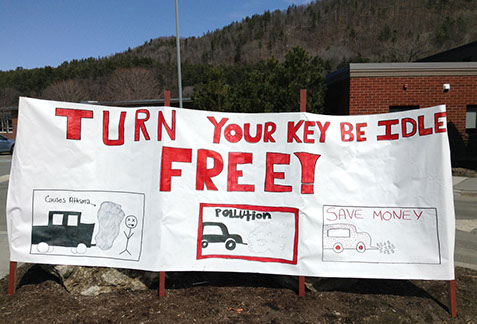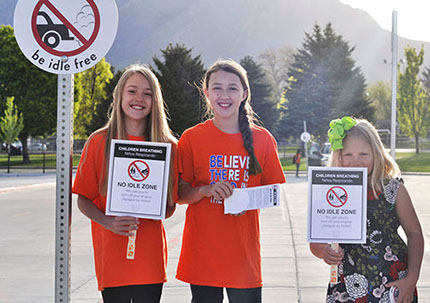California Idle-Free Schools
For the 2017-18 school year, Idle-Free California Inc. implemented Sacramento County Idle-Free Schools, a long term, student-led study and campaign that addressed the issue of prolonged idling of vehicles on school grounds.
This California Idle-Free Schools (CIFS) page is a resource for any teacher of any school on implementing a long-term or short-term idle-free schools campaign and/or idle-free classroom presentations on their own.
Why an idle-free schools project? The goal to eliminate idling on school grounds (and beyond) is a real win-win. Not only do motorists save money in avoiding needless fuel consumption and engine wear, carbon emissions are reduced, energy is conserved, and, most importantly, our health — particularly of students — is protected.
The impact of idling at California schools: DOWNLOAD
The U.S. EPA states: "Idling vehicles contribute to air pollution and emit air toxins, which are pollutants known or suspected to cause cancer or other serious health effects. Monitoring at schools has shown elevated levels of benzene, formaldehyde, acetaldehyde and other air toxics during the afternoon hour coinciding with parents picking up their children. Children’s lungs are still developing, and when they are exposed to elevated levels of these pollutants, children have an increased risk of developing asthma, respiratory problems and other adverse health effects. Limiting a vehicle’s idling time can dramatically reduce these pollutants and children’s exposure to them."
Idle-Free Schools campaigns
Idle-Free Schools campaigns address the issue of idling “hot spots” at many schools, for instance when parents pick up students in afternoon pick up areas (California regulates the idling of school buses and other heavy-duty vehicles at or near schools; light-duty vehicles are not regulated).
A CIFS project is tailored for middle school* science, math, STEM, health, and environmental teachers and their students to conduct idle-free campaigns. The presentation resources below include a 40-45 minute PowerPoint and videos explaining what idling is, the benefits in avoiding it, and campaign steps, along with handouts for students and teacher toolkit. These campaigns are offered in two levels of commitment: long-term efforts and short-term efforts.
math, STEM, health, and environmental teachers and their students to conduct idle-free campaigns. The presentation resources below include a 40-45 minute PowerPoint and videos explaining what idling is, the benefits in avoiding it, and campaign steps, along with handouts for students and teacher toolkit. These campaigns are offered in two levels of commitment: long-term efforts and short-term efforts.
A long-term effort is actually a measurable study and
campaign combined. It can span part to most of a school year with a student-led study of unobtrusive data collection, schools announcing support of an idle-free campaign in the school community, a student-led driver contact event, and final data collection to determine a difference.
A short-term effort is strictly a campaign. It is simpler and though not measurable, still effective in making a difference. It can span as little as one month with schools disseminating information in the school community on the benefits of avoiding idling, followed by a student-led driver contact event.
PROJECT DETAILS AND RESOURCES BELOW.
NOTE: Parents/parent clubs/PTOs are encouraged to participate!
In addition to the benefits in idling reduction these efforts provide:
1. students learn organizational, analytical and communication skills as they perform data analysis, are empowered by showing drivers the significant benefits in shutting off engines when parked, and take pride in making a positive difference in their school community.
2. motorists learning of the benefits potentially apply them beyond schools.
To help sustain either of these efforts, schools or school districts in proceeding years are strongly encouraged to remind the school community about the benefits in idle reduction several times each year, and to consider adopting policies, procedures, or handbook rules that limit idling on school grounds.
*While middle school students are at the ideal age to conduct these campaigns, they can also be conducted by high school students or, with more staff input, 5th and 6th graders.
PREVIOUS IDLE-FREE SCHOOLS PROJECTS
In addition to implementing the Sacramento County Idle-Free Schools project for the 2017-18 school year, Idle-Free California has also implemented funded Idle-Free Schools projects in the 2013-14, 2014-15, and 2015-16 school years in Vermont under the organization's former name of Idle-Free VT Inc. For school participation details of these successful initiatives, please visit Vermont Idle-Free Schools Archive page.
Campaign Steps: Two Levels of Commitment

IDLE-FREE SCHOOLS CAMPAIGNS RESOURCES
The California Idle-Free Schools initiative includes resources below. Schools are welcome to download these resources, allowing teachers to implement these efforts on their own.
For campaigners and teacher toolkit:
• Initial training session suggested PowerPoint: can be tailored
from Sacramento County Idle-Free Schools PowerPoint
• How to conduct observations/measuring*
• Format for calculating data*
• How to conduct driver contact event
• Suggested script for driver contact event
• Driver contact event flyer handouts
• "turn your key be idle free" window cling decals
*Long-term effort only
For school administrators:
• School template: campaign newsletter announcement
• School template: letter to parents
• School template: pledge for parents
• School template: letter to delivery companies
• School template: letter to teachers and staff
• School template: no-idling policy
• School template: no-idling procedure
• No Idling Signs: one or two 12" x 18" or 15" x 21"
aluminum - suggested templates
California Idle-Free Schools Toolkit
LONG-TERM EFFORT: IDLING MEASURABLE STUDY & CAMPAIGN COMBINED
Step 1: in fall or early winter, initial training session conducted by teacher in the classroom, or by college level intern via video. All campaign materials (handouts, decals, and anti-idling signs) shipped to teachers.
Step 2*: in fall or early winter, students unobtrusively conduct four-day study of initial data collection of idling vehicles during afternoon dismissal, utilizing note-taking and timing devices.
NOTE: It is essential that participating students begin their observations at least 15 minutes prior to official dismissal.
OPTIONAL: supplemental data collection utilizing a school's CO2 or CO gas sensor, or other emissions analyzer and compatible interface.
Step 3: following initial study, school announces support for idle-free campaign in school community, including a notice in school newsletter and website, and optionally letter and pledge to parents and delivery companies. See "For school administrators" below for support resources.
idle-free campaign in school community, including a notice in school newsletter and website, and optionally letter and pledge to parents and delivery companies. See "For school administrators" below for support resources.
HIGHLY RECOMMENDED: schools obtain and install one to two no idling signs in strategic areas. Sign templates
Step 4: in mid to late winter, students conduct two-day driver contact event, reaching out to idling drivers with information handout and idle-free window decal, asking them to take no-idling pledge. Campaigners create idle-free posters to display at event. SUGGESTION: seek TV, radio, print and/or social media coverage by working with school district's communications office.
HIGHLY RECOMMENDED: for safety purposes, students, who will be walking amongst cars in pick up areas, should wear safety vests.
Step 5*: in early spring, Step 2 is repeated. The difference between before and after data collection is then calculated to determine a difference and the effects of student's educational efforts.
*NOTE: to determine a true data set, it is important to conduct initial and final data collections in similar temperature ranges.
SHORT-TERM EFFORT: CAMPAIGN
Full educational value of long-term efforts without measuring
Step 1: anytime before late winter, initial training session as in long-term effort.
Step 2: following initial training session, school disseminates information in the school community on the benefits of avoiding idling; obtaining and installing no idling signs strongly recommended as above.
Step 3: within two weeks, driver contact event as in Step 4 above.
Video #1
"It's Not Cool to Idle at School"
(car racing sound at end of video edited out on presented video)
Video #2
Dr. Gerald S. Davis Idle-Free Talk
Video #3
U.S. EPA Region 8 Idle Free Schools Toolkit for a Healthy School Environment
The Idle-Free Schools campaign is closely modeled on THIS video and is an important component of the initial training session (Step 1)
